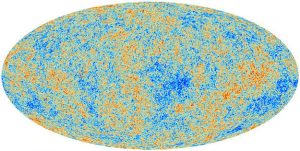Over the past week there have been a series of news articles reporting that two physicists, Niayesh Afshordi at the University of Waterloo in Canada along with Joao Magueijo at the Imperial College of London have proposed that Einstein may have been wrong. The Speed of Light may not be constant, right after the Big Bang it may have been a lot faster.
Do you want the short answer or the long answer. For the short answer read the next 3 paragraphs, for the long answer keep going. If you want to read the news report use the link below.
What Afshordi and Magueijo were looking for is a solution to the problem in cosmology of just how the early universe was in such good thermal equilibrium as is evidenced by the Cosmic Microwave Background, CMB see picture below. For different objects, at different initial temperatures to come into thermal equilibrium requires some kind of contact between those different objects. In this case we are taking about the entire early Universe which is flying apart at the speed of light and that ain’t good contact.

What Afshordi and Magueijo have proposed is that, in the Early Universe the speed of light was far greater than it is now allowing greater thermal contact by the process of radiation. Remember there are three ways for heat to flow: conduction, convection and radiation, well Afshordi and Magueijo’s model would make radiation a much more efficient process thereby eliminating the thermal contact problem.
The point to remember here is that this is all mathematics at present, no one has measured a different value for the speed of light. Afshordi and Magueijo do make a prediction of the scalar fluctuations in the CMB as an experimental check but at the moment this is all just a model.
Also, we’ve been here before. The problem of thermal equilibrium in the CMB goes back to the 1970s when Alan Guth of MIT proposed cosmic inflation as the solution. The idea of inflation was that, right after the big bang itself, and we’re taking pico-seconds here, a huge amount of energy was dropped into the universe causing it to expand faster than the speed of light so that a small section of the universe that was in thermal equilibrium became the entire universe that we see. For thirty years after Guth published his model inflation was a standard part of cosmology, I learned it, but no one has been able to figure out where all that energy came from so inflation is no longer quite so highly regarded.
To me however, this new idea of Afshordi and Magueijo is just kind of the opposite of inflation. Instead of having a small part of the universe after the big bang expand faster than the speed of light they increase the speed of light, in a sense making the early universe smaller. And they now have the problem of describing what made the speed of light so different, and what makes it so constant now? Kind of the opposite of Guth’s problem of where all that energy came from. I wish Afshordi and Magueijo luck but as I said, we’ve been here before.
Now I get to give my opinion. To me the reason the early universe was in thermal equilibrium right after the big bang was that it was in thermal equilibrium before the big bang. That’s right I’m one of those big crunch guys, that is I think that about 15 billion years ago, before the big bang, the universe was collapsing at the speed of light. Eventually the universe collapsed as much as it could and then rebounded, that rebound is what we call the big bang. A universe that is collapsing is coming into greater contact and therefore will achieve thermal equilibrium before the rebound, giving it thermal equilibrium after the rebound.
Anyway, that’s what I think. I know this has been a bit of a long post but I hope you enjoyed it. Let me know what you think.



